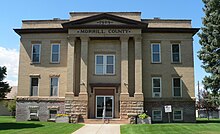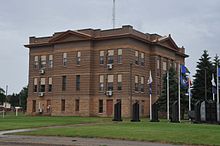
William LaBarthe Steele was an American architect from Chicago, Illinois. He is considered a principal member of the Prairie School Architectural Movement during the early 20th century.
Purcell & Elmslie (P&E) was the most widely know iteration of a progressive American architectural practice. P&E was the second most commissioned firm of the Prairie School, after Frank Lloyd Wright. The firm in all iterations was active from 1907 to 1921, with their most famous work being done between 1913 and 1921.

Charles Henry Owsley (1846–1935) was an English-born American architect in practice in Youngstown, Ohio from 1872 until 1912.

Proudfoot & Bird was an American architectural firm that designed many buildings throughout the Midwest region of the United States. Originally established in 1882, it remains active through its several successors, and since 2017 has been known as BBS Architects | Engineers.

Link & Haire was a prolific architectural firm in Montana, formally established on January 1, 1906. It designed a number of buildings that are listed on the National Register of Historic Places.

George Anthony Berlinghof was a German-born architect who designed a number of important buildings in Lincoln and other cities in Nebraska. Some of his surviving works are listed on the National Register of Historic Places.
Frost & Granger was an American architectural partnership from 1898 to 1910 of brothers-in-law Charles Sumner Frost (1856–1931) and Alfred Hoyt Granger (1867–1939). Frost and Granger were known for their designs of train stations and terminals, including the now-demolished Chicago and North Western Terminal, in Chicago. The firm designed several residences in Hyde Park, Illinois, and many other buildings. Several of their buildings are listed on the U.S. National Register of Historic Places.

Hugill & Blatherwick was an architectural firm in Sioux Falls, South Dakota that was founded by George C. Hugill and Wilfred F. Blatherwick circa 1921. A number of their works are listed on the U.S. National Register of Historic Places.
Frank E. Wetherell was an American architect in the U.S. state of Iowa who was active from 1892 to 1931. He founded the second oldest architectural firm in the state in Des Moines, Iowa, in 1905. He worked with Roland Harrison in partnership Wetherell & Harrison. The firm designed numerous Masonic buildings.

Haxby & Gillespie was an architectural firm from Fargo, North Dakota. R. J. Haxby and William D. Gillespie were the partners. The firm "produced a number of important buildings throughout North Dakota." They designed many notable public, educational, commercial, and church buildings, in North Dakota, Minnesota, and Montana.
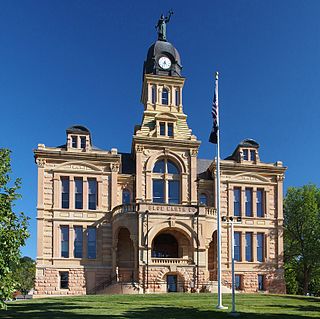
Truman Dudley Allen (1829-1897), commonly known as T. D. Allen or T. Dudley Allen, was an American architect. He moved frequently throughout his career, practicing in Iowa, Minnesota, Nebraska, Ohio and Wisconsin, but most of his prominent works date from his residence in Minneapolis at the close of his career.
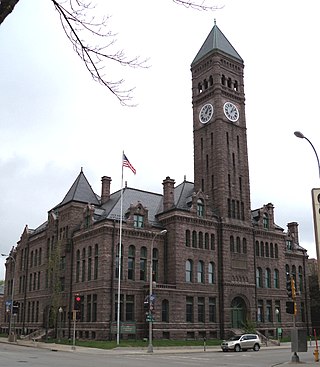
Wallace L. Dow (1844-1911), often known as W. L. Dow, was an architect of Sioux Falls, South Dakota. He has been referred to as the "Builder on the Prairie" and was "considered the premier architect of South Dakota in the late 19th century."

St. Anthony's Roman Catholic Church is a historic church at 329 S. 3rd Street in Sterling, Colorado, United States. It was built in 1911 and was added to the National Register of Historic Places in 1982.

Brynjulf Rivenes, generally known as B. Rivenes, was a Norwegian-American architect practicing in Miles City, a city in sparsely settled eastern Montana.

Ernest C. S. Holmboe (1873–1954) was an American architect best known for his work in West Virginia.

Beuttler & Arnold was an architectural firm in Sioux City, Iowa that designed several works that are listed on the National Register of Historic Places for their architecture.
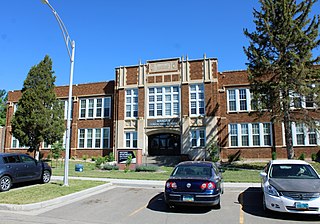
Gilbert R. Horton FAIA (1888–1985) was an American architect in practice in Jamestown, North Dakota from 1913 until 1980.

The Walworth County Courthouse, located at 4304 4th Ave. in Selby, South Dakota, is a courthouse for Walworth County, South Dakota which was built in 1911. It was listed on the National Register of Historic Places in 1999.

The Rawlins County Courthouse is a courthouse in Atwood, Kansas, serving Rawlins County. It was designed by Sioux City, Iowa, architects the Eisentraut-Colby-Pottenger Company.

Robert A. Ritterbush FAIA (1891–1980) was an American architect in practice in Bismarck, North Dakota, from 1920 until 1967.


